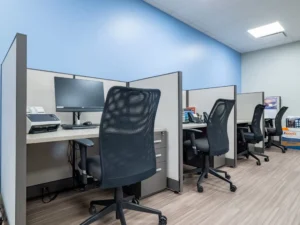
As the world of work undergoes seismic shifts, the focus on workplace wellness has become an integral aspect of business strategy. One of the crucial moments to prioritize this focus is during office relocations – a process fraught with logistical challenges that also brings an opportunity to redefine wellness within the workspace.
David Steinbrecher, CEO of InterWork, pioneers in modern workspace solutions and logistics, provides some valuable insights on the matter. “Office relocations in today’s landscape aren’t just about transitioning physical locations. It’s about embracing change, supporting hybrid work models, hoteling concepts, and reimagining how we use our office spaces,” Steinbrecher notes.
Relocations aren’t just about a physical move; they offer a chance to reconfigure workspaces in alignment with today’s work trends and employee wellness needs. From mental and emotional health to workspace flexibility and community-building, all aspects of wellness should be considered in this process. Here’s how:
Pre-Move Communication: Communication is crucial, especially when dealing with hybrid teams. Employees should be kept informed about the moving process, how the new workspace is designed to support their wellness, and what it means for their day-to-day work. Steinbrecher suggests, “Transparent, regular updates about the relocation process can ease anxieties, especially in hybrid work teams where remote workers might feel left out of the loop.”
Design for Flexibility: A significant aspect of today’s workspace is flexibility. The new office design should cater to various work styles – remote, in-office, or hybrid. Incorporating hoteling spaces, collaborative zones, quiet areas, and elements that enhance well-being like natural light, good air quality, and noise control features can greatly improve the work experience. Steinbrecher states, “Our office spaces should reflect the diversity of our workstyles. A one-size-fits-all approach no longer works.”
Space Repurposing: With more employees working remotely, organizations have the opportunity to repurpose existing spaces to support collaboration, creativity, and wellness. Steinbrecher shares, “Underutilized spaces can be transformed into wellness rooms, collaboration zones, or learning corners. It’s about optimizing space for wellness and productivity.”
Post-Move Adjustments: Even after the move, the commitment to employee wellness should continue. Regular check-ins, feedback, and a willingness to make changes based on employee needs should be a part of the process. “The office space isn’t static; it’s dynamic, evolving with our team’s needs. It’s about creating a living, breathing workspace that supports wellness in all its forms,” Steinbrecher concludes.
The intersection of office relocations, hybrid work, and workplace wellness presents a unique opportunity to build a more positive, healthy, and productive workspace. As Steinbrecher succinctly puts it, “When we prioritize our people, we’re not just building better workspaces; we’re building a better business.”
Office relocations can be a challenging time, but with a focus on wellness and a thoughtful approach to the new realities of work, it can also be an exciting opportunity to innovate and prioritize employee well-being like never before.





